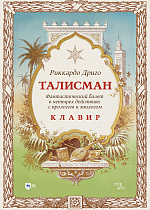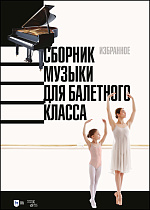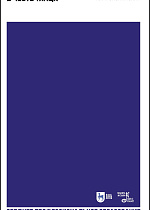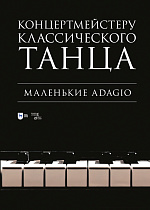Классический танец - все книги по дисциплине. Издательство Лань
Сохранить список:
Excel
Excel
Закрыть
Выгрузка списка книг доступна только авторизованным пользователям. Авторизоваться
В учебнике танца выдающегося педагога русской балетной школы А. Я. Вагановой (1879–1951) подробно, шаг за шагом, излагаются основы классического балетного танца, так называемая «Система Вагановой». Оставаясь глубоко национальной по духу и по манере танцевальных движений, она вобрала в себя как опыт французской и итальянской балетных школ, существенно переработанный на русской почве, так и личный сценический и педагогический опыт автора.
Учебник предназначен для учеников балетных школ, педагогов танца и всех интересующихся техникой и историей русского балетного искусства.
In the textbook of dance by an outstanding teacher of Russian ballet school A. Y. Vaganova, the fundamentals of the classical dance, so-called the Vaganova method, are expounded thouroughly, step by step. While remaining profoundly indigenous on a spiritual level and in the manner of dance moves, it absorbed not only the experience of French and Italian ballet schools, substantially modified for the Russian identity, but also the personal and pedagogical proficiency of the author.
The textbook is intended for students of ballet schools, teachers of dance and all interested in the technique and history of Russian ballet art.
Учебник предназначен для учеников балетных школ, педагогов танца и всех интересующихся техникой и историей русского балетного искусства.
In the textbook of dance by an outstanding teacher of Russian ballet school A. Y. Vaganova, the fundamentals of the classical dance, so-called the Vaganova method, are expounded thouroughly, step by step. While remaining profoundly indigenous on a spiritual level and in the manner of dance moves, it absorbed not only the experience of French and Italian ballet schools, substantially modified for the Russian identity, but also the personal and pedagogical proficiency of the author.
The textbook is intended for students of ballet schools, teachers of dance and all interested in the technique and history of Russian ballet art.
Читателям впервые предлагается издание клавира балета Риккардо Дриго «Талисман». Единственный в творчестве композитора «большой балет» на фантастический сюжет в четырех действиях с прологом и эпилогом, он был поставлен впервые в 1889 году М. Петипа, а затем — в 1909 году Н. Легат представил на сцене новую редакцию. Публикация фортепианного переложения, сделанного самим композитором, даёт уникальную возможность познакомиться с музыкой этого спектакля.
Клавир дополнен текстом либретто К. Тарновского — М. Петипа, а также научными статьями, посвященными жизни и творчеству Р. Дриго, истории создания балета и особенностям его музыкальной драматургии.
Издание будет полезно хореографам и балетмейстерам-реставраторам, концертмейстерам балета, педагогам и учащимся хореографических учебных заведений, балетоведам, культуроведам и музыковедам, изучающим историю балета и балетной музыки, а также всем любителям балетного театра.
This is the first edition of a piano score of The Talisman, the ballet by Riccardo Drigo. The composer’s only “grand ballet” on a fantastic plot in four acts with a prologue and epilogue, it was staged in 1889 by M. Petipa, and then in 1909 by N. Legat who presented a new stage version. The publication of the piano reduction made by the composer himself gives a unique opportunity to get acquainted with the music of this performance.
The piano score is supplemented with the libretto by K. Tarnovsky — M. Petipa, as well as the researches’ articles devoted to the life and work of Drigo, the history of the ballet creation and the features of its music dramaturgy.
The edition will be useful to choreographers and ballet restorers, ballet accompanists, teachers and students of choreographic schools, ballet experts, culture experts and musicologists studying the ballet history and ballet music history, as well as all admirers of ballet theatre.
Клавир дополнен текстом либретто К. Тарновского — М. Петипа, а также научными статьями, посвященными жизни и творчеству Р. Дриго, истории создания балета и особенностям его музыкальной драматургии.
Издание будет полезно хореографам и балетмейстерам-реставраторам, концертмейстерам балета, педагогам и учащимся хореографических учебных заведений, балетоведам, культуроведам и музыковедам, изучающим историю балета и балетной музыки, а также всем любителям балетного театра.
This is the first edition of a piano score of The Talisman, the ballet by Riccardo Drigo. The composer’s only “grand ballet” on a fantastic plot in four acts with a prologue and epilogue, it was staged in 1889 by M. Petipa, and then in 1909 by N. Legat who presented a new stage version. The publication of the piano reduction made by the composer himself gives a unique opportunity to get acquainted with the music of this performance.
The piano score is supplemented with the libretto by K. Tarnovsky — M. Petipa, as well as the researches’ articles devoted to the life and work of Drigo, the history of the ballet creation and the features of its music dramaturgy.
The edition will be useful to choreographers and ballet restorers, ballet accompanists, teachers and students of choreographic schools, ballet experts, culture experts and musicologists studying the ballet history and ballet music history, as well as all admirers of ballet theatre.
Впервые предлагается издание клавира балета Риккардо Дриго «Роман Бутона розы». Балет в 1904 году готовился Мариусом Петипа для постановки в Эрмитажном театре, но так и не был показан зрителям, и современная публикация фортепианного переложения, сделанного самим композитором – редчайшая возможность познакомиться с музыкой неосуществленного спектакля.
Клавир дополнен текстом либретто, сочиненным Иваном Александровичем Всеволожским и Мариусом Петипа, а также научными статьями, посвященными жизни и творчеству Дриго, истории создания балета и особенностям его музыкальной драматургии.
Издание будет полезно хореографам и балетмейстерам-реставраторам, концертмейстерам балета, педагогам и учащимся хореографических учебных заведений, балетоведам, культуроведам и музыковедам, изучающим историю балета и балетной музыки, а также всем любителям балетного театра.
This is the first edition of a piano score of The Romance of a Rosebud, the ballet by Riccardo Drigo. The ballet was choreographed by Marius Petipa in 1904 for production at the Hermitage Theatre, but was never shown to the audience, and the current publication of the piano transcription made by the composer himself is a rare opportunity to get acquainted with the music of a lost performance.
The piano score is supplemented with the libretto written by Ivan Aleksandrovich Vsevolozhsky and Marius Petipa, as well as the researches’ articles devoted to the life and work of Drigo, the history of the ballet creation the features of its music dramaturgy.
The edition will be useful to choreographers and ballet restorers, ballet accompanists, teachers and students of choreographic schools, ballet experts, culture experts and musicologists studying the ballet history and ballet music history, as well as all admirers of ballet theatre.
Клавир дополнен текстом либретто, сочиненным Иваном Александровичем Всеволожским и Мариусом Петипа, а также научными статьями, посвященными жизни и творчеству Дриго, истории создания балета и особенностям его музыкальной драматургии.
Издание будет полезно хореографам и балетмейстерам-реставраторам, концертмейстерам балета, педагогам и учащимся хореографических учебных заведений, балетоведам, культуроведам и музыковедам, изучающим историю балета и балетной музыки, а также всем любителям балетного театра.
This is the first edition of a piano score of The Romance of a Rosebud, the ballet by Riccardo Drigo. The ballet was choreographed by Marius Petipa in 1904 for production at the Hermitage Theatre, but was never shown to the audience, and the current publication of the piano transcription made by the composer himself is a rare opportunity to get acquainted with the music of a lost performance.
The piano score is supplemented with the libretto written by Ivan Aleksandrovich Vsevolozhsky and Marius Petipa, as well as the researches’ articles devoted to the life and work of Drigo, the history of the ballet creation the features of its music dramaturgy.
The edition will be useful to choreographers and ballet restorers, ballet accompanists, teachers and students of choreographic schools, ballet experts, culture experts and musicologists studying the ballet history and ballet music history, as well as all admirers of ballet theatre.
Предлагаемое издание посвящено одной из важнейших постановок московского балетмейстера Александра Алексеевича Горского (1871–1924) — мимодраме «Дочь Гудулы». Она была показана в 1902 году и, несмотря на то что быстро сошла со сцены, в истории отечественного балета осталась не только как первое реформаторское произведение своего автора, но и как своего рода точка отсчёта преобразований в русском хореографическом театре.
Две части уникального издания одновременно и дополняют друг друга, и представляют самостоятельный интерес. Клавир мимодрамы впервые предлагается читателям, в исследовании даётся краткая история создания и сценической жизни постановки и подробно анализируется музыка «Дочери Гудулы» — та составляющая спектакля, которая способна сохраняться вне зависимости от прошедшего со времени премьеры времени.
Издание будет интересно теоретикам и практикам балета, музыковедам, культурологам и всем любителям музыкального театра.
The current edition is devoted to the mime drama Gudula’s Daughter, one of the most important productions by Alexander Alexeevich Gorsky (1871–1924), the Moscow ballet master. It was first shown in 1902 and, despite the fact that it quickly disappeared from stage, it remained in the Russian ballet history not only as the first innovative work of its author, but also as a kind of a starting point for transformations in the Russian choreographic theater.
Two parts of this unique edition complement each other and are at the same time of independent interest. The piano score of the mime drama is published for the first time, the study provides a brief history of the creation and stage life of the production and analyzes in detail the music of the Gudula’s Daughter, that part of the performance that can continue to exist regardless of the time that has passed since the premiere.
The edition will be of interest to ballet theorists and practitioners, musicologists, culture experts and all the music theater lovers.
Две части уникального издания одновременно и дополняют друг друга, и представляют самостоятельный интерес. Клавир мимодрамы впервые предлагается читателям, в исследовании даётся краткая история создания и сценической жизни постановки и подробно анализируется музыка «Дочери Гудулы» — та составляющая спектакля, которая способна сохраняться вне зависимости от прошедшего со времени премьеры времени.
Издание будет интересно теоретикам и практикам балета, музыковедам, культурологам и всем любителям музыкального театра.
The current edition is devoted to the mime drama Gudula’s Daughter, one of the most important productions by Alexander Alexeevich Gorsky (1871–1924), the Moscow ballet master. It was first shown in 1902 and, despite the fact that it quickly disappeared from stage, it remained in the Russian ballet history not only as the first innovative work of its author, but also as a kind of a starting point for transformations in the Russian choreographic theater.
Two parts of this unique edition complement each other and are at the same time of independent interest. The piano score of the mime drama is published for the first time, the study provides a brief history of the creation and stage life of the production and analyzes in detail the music of the Gudula’s Daughter, that part of the performance that can continue to exist regardless of the time that has passed since the premiere.
The edition will be of interest to ballet theorists and practitioners, musicologists, culture experts and all the music theater lovers.
Моцарт, Бетховен, Шопен, Шуберт, Шуман, Григ, Верди, Глинка, Рахманинов, Гуно, Фалья, Назарет, Босси, Ребиков, Милютин – это лишь неполный список композиторов, музыку которых вы найдете в этом сборнике, составленном для избранных упражнений балетного класса: Plié, Rond de jambe par terre, Fondu, Adagio, Диагональ.
Вы познакомитесь с произведениями разных эпох, стилей и жанров: от барокко и венской классики до джаза и музыки XX века; узнаете как многие известные сочинения, так и некоторые новые.
Издание предназначено для концертмейстеров балетных школ, театров, хореографических коллективов, преподавателей хореографии и балетмейстеров-постановщиков.
Mozart, Beethoven, Chopin, Schubert, Schumann, Grieg, Verdi, Glinka, Rachmaninoff, Gounod, Falla, Nazareth, Bossi, Rebikov, Milyutin — these are some composers whose music you will find in this collection, compiled to accompany the selected exercises of a ballet class: Plié, Rond de jambe par terre, Fondu, Adagio, Diagonal.
You will find here adaptations of pieces of different times, styles and genres: from baroque and Viennese classics to jazz and music of the 20th century; you will learn many famous compositions as well as some new ones.
The edition is addressed to accompanists at ballet schools, theaters, choreographic groups, choreography teachers and choreographers.
Вы познакомитесь с произведениями разных эпох, стилей и жанров: от барокко и венской классики до джаза и музыки XX века; узнаете как многие известные сочинения, так и некоторые новые.
Издание предназначено для концертмейстеров балетных школ, театров, хореографических коллективов, преподавателей хореографии и балетмейстеров-постановщиков.
Mozart, Beethoven, Chopin, Schubert, Schumann, Grieg, Verdi, Glinka, Rachmaninoff, Gounod, Falla, Nazareth, Bossi, Rebikov, Milyutin — these are some composers whose music you will find in this collection, compiled to accompany the selected exercises of a ballet class: Plié, Rond de jambe par terre, Fondu, Adagio, Diagonal.
You will find here adaptations of pieces of different times, styles and genres: from baroque and Viennese classics to jazz and music of the 20th century; you will learn many famous compositions as well as some new ones.
The edition is addressed to accompanists at ballet schools, theaters, choreographic groups, choreography teachers and choreographers.
Книга представляет наиболее полное и крупное собрание статей московского балетного и театрального критика начала ХХ века А. А. Черепнина (Э. А. Нуделя). В сборник вошли более сотни текстов о значимых событиях и повседневной жизни балетного и драматического театра, театров миниатюр, о музыкальных концертах и вечерах танца периода с 1909 по 1927 гг. Книга расширяет представление о культурной жизни Москвы в целом и балетной труппы Большого театра, об идеях, высказывавшихся в печати, о становлении и профессионализации московской балетной критики.
Книга предназначена для историков балета, танца, театра и критики, музыковедов, искусствоведов и культурологов, для студентов высших учебных заведений в области хореографического и театрального искусства, а также любителей балета.
The book represents the most complete and largest collection of articles by A. A. Tcherepnin (E. A. Nudel), the Moscow ballet and theatre critic of the early 20th century. The collection includes more than a hundred articles on significant events and the daily life of the ballet and drama theatre, miniature theatres, on musical recitals and dance soirées between 1909 and 1927. The book expands the knowledge of the cultural life of Moscow in general and the Bolshoi Theatre ballet troupe, of the ideas expressed in the media, of the formation and professionalization of Moscow ballet criticism.
The book is intended for historians of ballet, dance, theatre and criticism, musicologists, art historians and cultural experts, for students of higher schools of choreography and theatrical arts, as well as ballet lovers.
Книга предназначена для историков балета, танца, театра и критики, музыковедов, искусствоведов и культурологов, для студентов высших учебных заведений в области хореографического и театрального искусства, а также любителей балета.
The book represents the most complete and largest collection of articles by A. A. Tcherepnin (E. A. Nudel), the Moscow ballet and theatre critic of the early 20th century. The collection includes more than a hundred articles on significant events and the daily life of the ballet and drama theatre, miniature theatres, on musical recitals and dance soirées between 1909 and 1927. The book expands the knowledge of the cultural life of Moscow in general and the Bolshoi Theatre ballet troupe, of the ideas expressed in the media, of the formation and professionalization of Moscow ballet criticism.
The book is intended for historians of ballet, dance, theatre and criticism, musicologists, art historians and cultural experts, for students of higher schools of choreography and theatrical arts, as well as ballet lovers.
В данном сборнике представлены произведения в жанре салонной музыки и оперетты периода с середины XIX века до 40-х годов XX. Наряду с популярными мелодиями известными каждому, в сборнике открываются страницы музыки малознакомой, редко исполняемой, но не менее очаровательной. Среди имен – Ф. Легар, И. Кальман, И. Штраус, А. Аренский, М. Мошковский, М. Регер, С. Шаминад, П. Уэкс, Э. Харрисон и многие другие. Все пьесы подобраны для сопровождения уроков балетного класса.
Издание адресовано концертмейстерам балетных школ, театров, хореографических коллективов, преподавателям хореографии и балетмейстерам-постановщикам.
The current collection presents the pieces in the genre of salon music and operetta written between the mid-19th century and 1940s. Along with popular melodies known to anyone, the collection gives the examples of rare pages of music, little known and not so often performed, but still full of charm. Among the names are F. Lehár, I. Kálmán, J. Strauss, A. Arensky, M. Moszkowski, M. Reger, C. Chaminade, P. Wachs, A. Harrison and many others. All the pieces are intended for accompanying the lessons of a classical ballet.
The edition is addressed to accompanists at ballet schools, theaters, choreographic groups, choreography teachers and choreographers.
Издание адресовано концертмейстерам балетных школ, театров, хореографических коллективов, преподавателям хореографии и балетмейстерам-постановщикам.
The current collection presents the pieces in the genre of salon music and operetta written between the mid-19th century and 1940s. Along with popular melodies known to anyone, the collection gives the examples of rare pages of music, little known and not so often performed, but still full of charm. Among the names are F. Lehár, I. Kálmán, J. Strauss, A. Arensky, M. Moszkowski, M. Reger, C. Chaminade, P. Wachs, A. Harrison and many others. All the pieces are intended for accompanying the lessons of a classical ballet.
The edition is addressed to accompanists at ballet schools, theaters, choreographic groups, choreography teachers and choreographers.
В сборник вошли статьи историка балета Ю. И. Слонимского (1902–1978) 20–60-х годов XX века. Сохранив историческую достоверность выступлений в прессе, автор обобщает свой критический опыт относительно знаковых постановок прошлого века.
Соответствует современным требованиям Федерального государственного образовательного стандарта среднего профессионального образования и профессиональным квалификационным требованиям. Адресовано студентам средних специальных учебных заведений.
The collection includes articles by ballet historian Y. I. Slonimskiy (1902–1978) written between 1920s and 1960s. While keeping the historical accuracy of publications in the press, the author summarizes his experience of a critic regarding the iconic productions of the last century.
Corresponds to the modern requirements of the Federal State Educational Standard of Secondary Vocational Education and professional qualification requirements. It is addressed to students of colleges.
Соответствует современным требованиям Федерального государственного образовательного стандарта среднего профессионального образования и профессиональным квалификационным требованиям. Адресовано студентам средних специальных учебных заведений.
The collection includes articles by ballet historian Y. I. Slonimskiy (1902–1978) written between 1920s and 1960s. While keeping the historical accuracy of publications in the press, the author summarizes his experience of a critic regarding the iconic productions of the last century.
Corresponds to the modern requirements of the Federal State Educational Standard of Secondary Vocational Education and professional qualification requirements. It is addressed to students of colleges.
Данный сборник продолжает серию «Концертмейстеру классического танца». В сборнике представлены примеры для сопровождения упражнений на пальцах.
Издание предназначено для концертмейстеров училищ, школ искусств, любительских коллективов.
Издание предназначено для концертмейстеров училищ, школ искусств, любительских коллективов.
Данный сборник продолжает серию «Концертмейстеру классического танца». В сборнике представлены примеры музыкального оформления урока из раздела «Маленькие Adagio». Этот раздел отличается от Больших Adagio простотой формы, более прозрачной фактурой и
отсутствием яркой кульминации.
Издание предназначено для концертмейстеров училищ, школ искусств, любительских коллективов.
This collection continues the “To concertmaster of a classical dance” series. The collection presents examples of the music accompaniment of the Small Adagios part of the lesson. This part differs from the Grand Adagios by the simplicity of form, more transparent texture and lack of clear climax.
The edition is intended for accompanists at colleges, schools of arts, amateur groups.
отсутствием яркой кульминации.
Издание предназначено для концертмейстеров училищ, школ искусств, любительских коллективов.
This collection continues the “To concertmaster of a classical dance” series. The collection presents examples of the music accompaniment of the Small Adagios part of the lesson. This part differs from the Grand Adagios by the simplicity of form, more transparent texture and lack of clear climax.
The edition is intended for accompanists at colleges, schools of arts, amateur groups.











